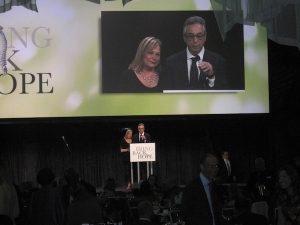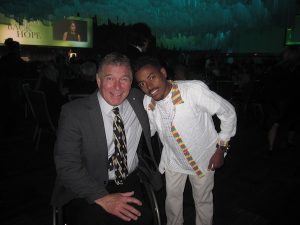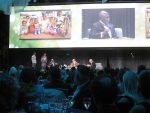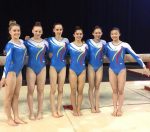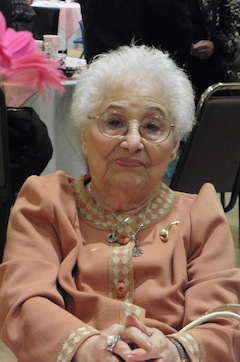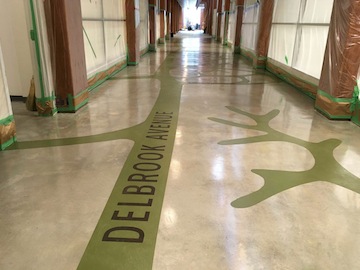Bard on the Beach’s The Merchant of Venice is set in modern times, where the character of Shylock, played by Warren Kimmel, is a high-powered businessman. (photo by David Cooper)
Among the Shakespearean works being presented by Bard on the Beach this season is The Merchant of Venice, which is being complemented with a short run of local playwright and Jewish community member Mark Leiren-Young’s one-man show Shylock. Fellow Jewish community member Warren Kimmel has taken on the daunting task of playing Shylock in both the main production and its eponymous companion piece.
There is continuing controversy over whether or not theatrical companies should produce Merchant. There are those who say the play should be relegated to the dustbin of history while others champion it as an opportunity for meaningful dialogue about outsiders and otherness.
In Merchant, Bassanio, an eligible Venetian bachelor, wishes to “wed wealthily” and woo the beautiful heiress Portia. To do so, he needs money. Enter his friend, Antonio, a successful merchant of Venice, who can guarantee a loan. Jewish moneylender Shylock is approached. Shylock, who has been ridiculed and despised by the citizens of Venice, especially Antonio, sees an opportunity for revenge and agrees to make the loan in return for Antonio’s bond, which, if forfeit, would give Shylock a “pound of Antonio’s flesh.”
Meanwhile, Portia’s father has devised a test for eligible suitors to win his daughter’s hand. The antics of the three suitors vying for the prize provide some comic relief for the tragedy that follows. Bassanio wins his lady but learns that Antonio’s ships have all been wrecked at sea and that the merchant cannot pay back the loan. Shylock is insisting upon his “pound of flesh” so Bassanio makes haste back to Venice.
This leads to a powerful courtroom scene where Portia, disguised as a young lawyer, makes an emotional plea in her “quality of mercy” speech. However, Shylock insists upon his legal rights and wins the suit. Just as he is about to take his “prize,” Portia points out to him that he is restricted to exactly one pound of flesh and not one drop of Christian blood is to be shed, or else Shylock will forfeit his own life. Shylock agrees to walk away but is nonetheless systematically stripped of all his possessions and forced to convert to Christianity.
“I was very flattered when Christopher Gaze, the artistic director, asked me to play Shylock in both plays,” Kimmel told the Independent. “This will be my Bard debut and the first time that I have played a really serious dramatic role in Canada, as my background has mostly been in musicals.”
Kimmel, born in South Africa, was trained in classical theatre at the Royal Academy of Dramatic Art in London, England. He compared Shakespeare’s iambic pentameter verses to the rhythm in songs, so there is no problem there, but he has been grappling with how to present this iconic character to audiences.
“The problem I have with the play is the portrayal of Shylock,” he said. “It is very complicated because it is antisemitic. But, at the same time, it is not just black and white. Shylock is not a nice guy, he is a piece of work – but a complicated one. On one side, he is an aggressive businessman but, on the other, he lost his wife, had a hell of a life and loves his daughter more than anything, perhaps too much … to the point that she wants to escape and does so by taking his money and running off with a gentile. So, I have an inner conflict to resolve to get into the character so that it makes sense to me.”
“That really is the central question, isn’t it – is this play sympathetic or not? This is the first time a Jew on stage has been portrayed as anything close to human and we can say Shakespeare is amazing for doing this. Or, let’s be honest, it is an antisemitic piece and the guy is basically cast as the villain for whom you have absolutely no sympathy.”
Some productions portray Shylock in a sympathetic light, while others paint him as the quintessential villain. “That really is the central question, isn’t it – is this play sympathetic or not? This is the first time a Jew on stage has been portrayed as anything close to human and we can say Shakespeare is amazing for doing this. Or, let’s be honest, it is an antisemitic piece and the guy is basically cast as the villain for whom you have absolutely no sympathy.”
This is the fourth time Bard will have produced Merchant and Kimmel is the third Jewish actor to take on the role. “You don’t have to be Jewish to play Shylock, just like you don’t have to be black to play Othello. However, I do believe there is a cultural sensitivity that a Jewish actor brings to the role,” said Kimmel.
Many with even only a passing knowledge of literature know who Shylock is, and the iconic “Hath not a Jew eyes” soliloquy is as well known as Hamlet’s “To be or not to be.”
“Funnily enough,” said Kimmel, “doing that soliloquy is not what worries me about the piece…. You can do it as a plea for justice or you can do it with more of an aggressive tone,” he said, paraphrasing the speech’s main point, “But what about us? We are the same as you, so we don’t need to take this from you anymore.”
“I have decided that I am not going to play it as a victim,” said Kimmel.
As to the courtroom scene where Shylock demands his “pound of flesh,” he said, “I think I have to play him there as a vengeful kind of guy, I just don’t see any other way to do it. Some productions try to show the struggle between the good soul and the bad soul, but I see him as unrelenting in his quest for the forfeit, even though he has been offered up to three times the original amount of the loan and even though he is aware that what he is doing is wrong, fully aware, but he can’t stop himself.
“That is what happens with big emotions like revenge – one gets tunnel vision. I sing a piece of the [Maurice] Ravel Kaddish, which is very ornate, just before the courtroom scene. The point of that is to show Shylock’s mindset, ‘Look, my wife is dead, my daughter is dead [to me], I have nothing left to live for, I am going to take this man’s pound of flesh.’ I think that I would like to play the character as sinister but understandable – that this is a steely, powerful guy who is saying, just because people are prejudiced against you, does not mean you have to be a victim.”
Bard on the Beach’s Merchant is being set in modern-day Venice.
“It is a pretend world, it has to be,” said Kimmel. “It is a corporate banking world of suits that centres around a group of high-powered businessmen. Shylock is one of them. He is savvy and a very powerful guy by virtue of the fact that he has a lot of money. There is a tension there in the play itself as, despite his money, he is treated as a second-class citizen. We are not playing up the religious aspect in terms of costuming so that the only outwardly visible sign of his Judaism will be the yarmulke that I will be wearing – he is a modern Jew.”
On the issue of whether or not the play is too offensive for contemporary sensitivities, Kimmel is thoughtful.
“I don’t think you should look at it with post-Holocaust eyes,” he said. “The fact that this version is set in modern times makes it even more difficult to digest. In the actual period, 1500, Jews were essentially reviled wherever they lived, and Shakespeare was just reflecting the animus of the time.”
Despite the antisemitism, Kimmel feels that the play is one of the great works of literature and that it is important to see it.
“I feel that, as actors, if we are not doing something that is offending someone, why are we doing it? We are supposed to provoke dialogue and conversation.”
Noting that “there is way too much political correctness in the world right now,” he said, “I feel that, as actors, if we are not doing something that is offending someone, why are we doing it? We are supposed to provoke dialogue and conversation. For example, when people are spitting on Shylock and calling him a dirty Jew, that has to be part of the story so you get what is going on. You can’t ask, does it offend you because people are spitting on you? That’s the story and that is part of why he goes and tries to cut someone’s heart out. You have to be driven to that, so what would drive you to do that? Once you get the back story, then you see the context of his actions.”
Kimmel believes audiences will get something different out of this version of the play than from the three previous productions. One of the reasons for this belief, he said, is that the director, Nigel Shawn Williams, is playing on the theme that we are all outsiders at one point or another. Kimmel wants people to leave the theatre challenged to sort out their feelings about what they have just seen.
Shylock will run for one week in September. In this work, the actor who plays Shylock comes out after the final performance of Merchant – the play has been shut down due to public pressure and, as part of a talk-back, the actor defends his participation in it as a Jew and explains why it is important to stage Shakespeare’s play.
“I am more excited about that piece because, with it, I know exactly where I am at and I get the arguments from both sides,” said Kimmel. “It was written specifically for Bard and Vancouver to run alongside its 1996 Merchant production with local community member David Berner playing the Jewish actor.”
Kimmel said, “The play seems to say that you can’t censor something just because it offends you. Why can’t you have a Jewish villain? Why don’t we just stop doing anyone who is in any way compromised?”
Audiences will be exposed to a range of perspectives on history, censorship, identity and the meaning of art in this intensive 90-minute offering, which is being directed by first-time Bard director Sherry Yoon, who will be fleshing (pun intended) out the play with projections and sound effects.
“Shylock is a character that has endured for over 400 years. He is the best-known Jewish character in literature. There are people the world over who know what a shylock is. That is because he is so fascinating. Jews are fascinating people.”
“This is the first great Shakespearean character,” said Kimmel of Merchant’s Shylock. “After this comes Othello, Hamlet and Lear. It is really the first time Shakespeare goes from silly comedies with twins with mistaken identities to serious roles that fascinate humanity through time. Shylock is a character that has endured for over 400 years. He is the best-known Jewish character in literature. There are people the world over who know what a shylock is. That is because he is so fascinating. Jews are fascinating people.”
The play had been used to incite hatred against Jews – the Nazis in particular promoted it because it fit in with their worldview.
“That is exactly why it is important for everyone to see Merchant for themselves,” said Kimmel, “so you don’t get the story secondhand – you should be exposed to it, not told about it.”
Bard on the Beach runs until Sept. 24. Its other productions this season are Much Ado About Nothing, Winter’s Tale and Two Gentleman of Verona. For the full schedule and tickets, visit bardonthebeach.org.
Tova Kornfeld is a Vancouver freelance writer and lawyer.
